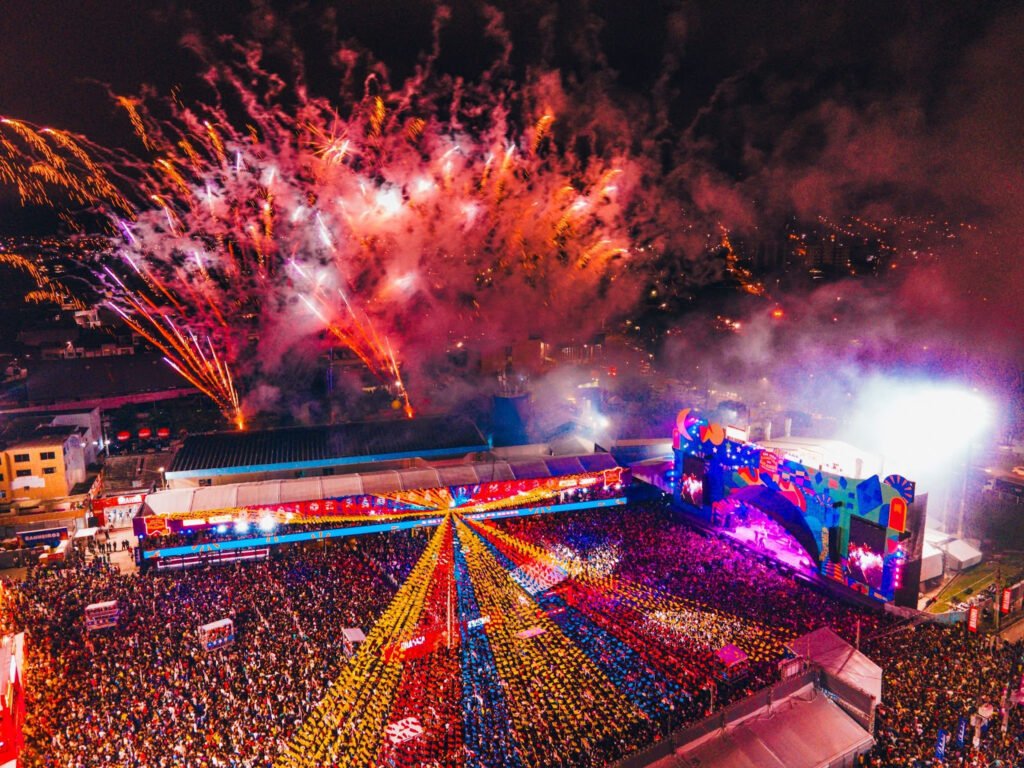In the heart of Brazil’s vibrant Northeast region, as June approaches, an extraordinary cultural phenomenon begins to unfold. Streets become adorned with colorful flags, the aroma of traditional corn-based delicacies fills the air, and the contagious rhythms of forró music echo through cities and towns. This is the season of São João (Saint John’s) festivals – Brazil’s second-largest cultural celebration after Carnival, yet one that remains relatively undiscovered by international tourists.
At the epicenter of this cultural explosion are two rival cities: Campina Grande in Paraíba state and Caruaru in Pernambuco state. For decades, these neighboring cities have engaged in a passionate, sometimes fierce competition for the coveted title of “The Biggest Saint John’s Festival in the World.” This rivalry has transformed what were once local community celebrations into massive, month-long spectacles that attract millions of visitors and generate significant economic impact.
But what makes these festivals so special? Why do Brazilians travel from across the country to attend them? And most intriguingly – which city truly deserves the title of hosting the world’s largest São João celebration?
This article takes you deep into the heart of Brazil’s most authentic cultural celebration, exploring the rich history, distinctive characteristics, and fascinating rivalry between these two Northeastern powerhouses of tradition and festivity. Whether you’re planning a visit or simply curious about this remarkable cultural phenomenon, join us as we unravel the colorful, musical, and deliciously complex world of Brazil’s greatest June festivals.
The Historical Context of Saint John’s Festivals in Brazil
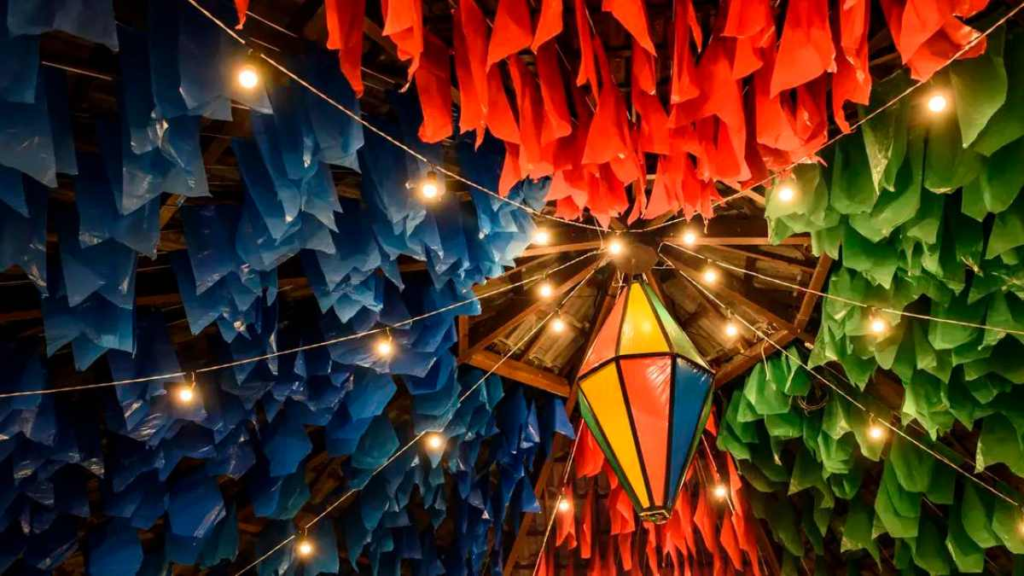
To understand the magnitude and significance of the São João festivals in Campina Grande and Caruaru, we must first explore their historical roots, which stretch back to Brazil’s colonial period and even further into European traditions.
European Origins and Brazilian Adaptation
Saint John’s festivals originated in Europe as pagan midsummer celebrations marking the summer solstice. When Portuguese colonizers arrived in Brazil in the 16th century, they brought these traditions with them, adapting them to the Catholic calendar and dedicating them to three saints celebrated in June: Saint Anthony (June 13), Saint John (June 24), and Saint Peter (June 29).
What began as religious observances gradually incorporated local elements, creating a uniquely Brazilian cultural expression. In the rural communities of Brazil’s Northeast, these celebrations became particularly significant, serving as rare opportunities for isolated farming families to gather, socialize, and arrange marriages for their children.
The traditional elements of these celebrations included bonfires (symbolizing the light that announced the birth of Saint John the Baptist), colorful decorations, folk dances, matchmaking games, and an abundance of food made from corn and other seasonal ingredients harvested during this period.
From Rural Traditions to Urban Spectacles
As Brazil urbanized throughout the 20th century, these rural traditions migrated to cities, where they evolved into larger community celebrations. By the 1970s and 1980s, municipal governments in the Northeast began recognizing the potential of these festivals to attract tourists and stimulate local economies.
This transformation was particularly pronounced in Campina Grande and Caruaru, where local authorities made deliberate efforts to expand and promote their São João celebrations. What had once been neighborhood gatherings with modest bonfires and homemade decorations gradually evolved into massive, professionally organized events with elaborate infrastructure, famous musical performers, and significant public and private investment.
Cultural Significance in the Brazilian Northeast
In Brazil’s Northeast region, São João festivals hold a cultural significance comparable to or even surpassing Carnival. They represent a powerful expression of regional identity, celebrating rural traditions, Northeastern music (particularly forró), traditional cuisine, and local customs.
Unlike Carnival, which has been heavily commercialized and internationalized, São João celebrations maintain a stronger connection to authentic Brazilian traditions and regional culture. They serve as a counterpoint to the coastal, urban culture often associated with Brazil, highlighting instead the rich heritage of the country’s interior regions.
For Northeasterners who migrated to other parts of Brazil, these festivals also became important occasions to reconnect with their cultural roots. Many travel back to their hometowns in June specifically to participate in the celebrations, reinforcing family and community bonds.
This deep cultural significance helps explain why cities like Campina Grande and Caruaru have invested so heavily in their São João festivals and why the competition between them has become so intense. These are not merely tourist events but profound expressions of regional pride and identity, with each city claiming to be the most authentic and impressive representative of this beloved tradition.
Campina Grande: The Biggest São João in the world?
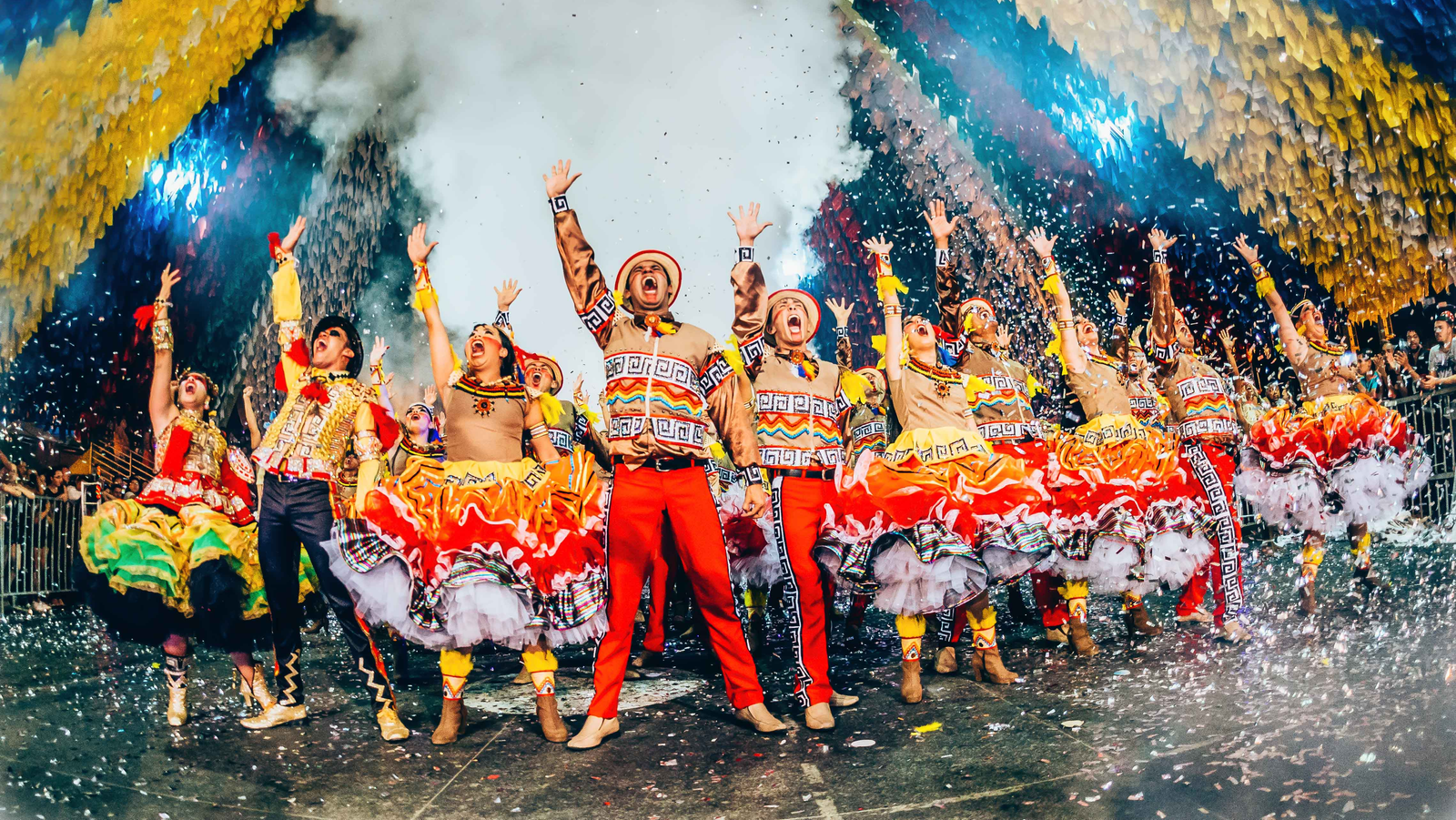
In the state of Paraíba, the city of Campina Grande proudly calls itself the host of “O Maior São João do Mundo” (The Biggest Saint John’s Festival in the World). This bold claim isn’t made lightly – the festival has evolved into a spectacular 33-day cultural marathon that transforms the entire city into a celebration of Northeastern Brazilian traditions.
History and Evolution
Campina Grande’s São João festival began as a community celebration but took on new dimensions in the 1980s when local authorities recognized its potential as a tourist attraction. The city, already known as an important commercial and educational center in the Northeast, decided to leverage its strategic location and infrastructure to create a festival that would stand out nationally.
The modern incarnation of the festival was formalized with the creation of the “Parque do Povo” (People’s Park), a dedicated 42,000-square-meter (452,000-square-foot) space in the heart of the city specifically designed to host the annual celebration. This permanent venue allowed the festival to grow in scale and ambition year after year.
By the 1990s, Campina Grande’s São João had already gained national recognition, and by the early 2000s, it was actively promoting itself internationally as the world’s largest Saint John’s festival – a claim that would soon be contested by neighboring Caruaru.
The Spectacular Parque do Povo
The centerpiece of Campina Grande’s festival is the Parque do Povo, which undergoes a remarkable transformation each June. The park becomes a “Cidade Cenográfica” (Scenographic City) – an elaborate recreation of a traditional Northeastern town, complete with a church, town square, and rustic houses.
This picturesque setting serves as the backdrop for over 700 hours of forró music and dance, performances by more than 300 folkloric groups, and appearances by Brazil’s biggest musical stars. The 2025 lineup includes legendary Northeastern artists like Alceu Valença and Elba Ramalho alongside contemporary superstars such as Wesley Safadão, Gusttavo Lima, Henrique & Juliano, and Zé Vaqueiro.
The park features multiple stages, food stalls serving traditional June festival delicacies, handicraft markets, and areas for traditional games and activities. Each night, the festivities continue until sunrise, with thousands of people dancing forró under the stars.
Distinctive Cultural Elements
What sets Campina Grande’s festival apart are several unique attractions that have become synonymous with its celebration:
The Trem do Forró (Forró Train): A special train journey that takes visitors through the countryside while musicians perform traditional forró onboard. This nostalgic experience recalls the era when trains were the primary mode of transportation in the region.
Quadrilha Competitions: Elaborate folk dance competitions featuring teams in traditional costumes performing choreographed routines that tell the story of a rural wedding. These competitions are taken extremely seriously, with teams practicing for months and investing significantly in costumes and props.
Ilha do Maior São João do Mundo: A dedicated cultural space that operates year-round, preserving and showcasing the traditions of the June festivals even outside the celebration period.
Spectacular Fireworks Displays: Nightly pyrotechnic shows that light up the sky above Parque do Povo, creating a magical atmosphere that has become one of the festival’s trademarks.
Economic and Tourism Impact
The São João festival is often described as the “economic lifeblood” of Campina Grande. During the 33 days of celebration, the city’s population effectively doubles with an influx of more than 2 million visitors.
This massive tourism surge generates thousands of temporary jobs and millions of dollars in revenue for local businesses. Hotels reach 100% occupancy, restaurants operate at full capacity, and the informal economy thrives with street vendors and temporary workers finding abundant opportunities.
For musicians and artists, particularly those specializing in forró and traditional Northeastern styles, the festival represents the most important earning period of the year. Many performers make a significant portion of their annual income during these few weeks.
The international promotion of the festival has also put Campina Grande on the global cultural map. In recognition of its cultural significance, UNESCO included the city in its Creative Cities Network, acknowledging its contribution to preserving and promoting traditional music and festivities.
As one visitor from São Paulo commented: “There’s nothing like São João in Campina Grande. The energy, the music, the people – it’s Brazil at its most authentic and joyful. I’ve been coming for five years straight, and each time it gets better.”
Caruaru: The Capital of Forró
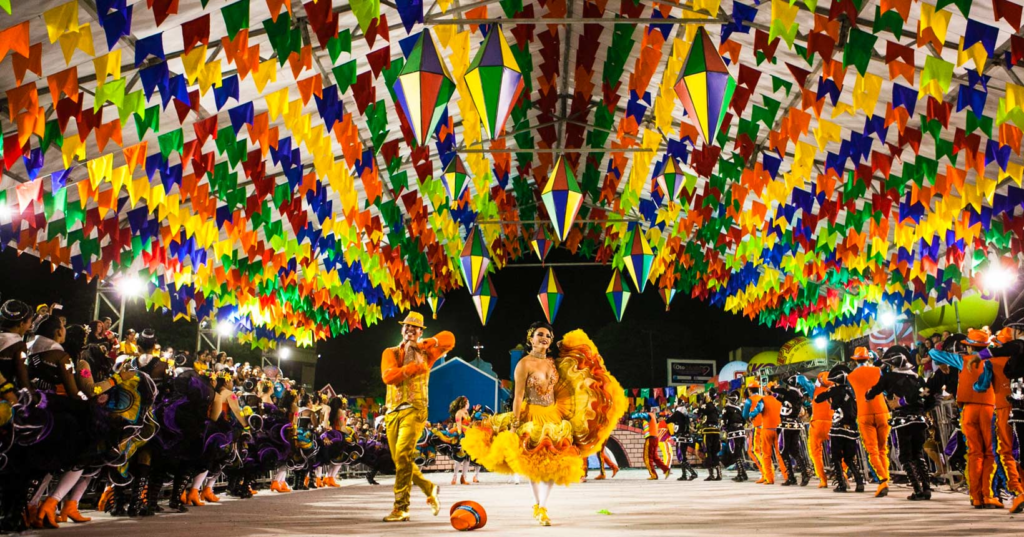
In the state of Pernambuco, approximately 130 kilometers (80 miles) from Recife, lies Caruaru – a city that proudly proclaims itself the “Capital of Forró” and host to what many consider the most authentic and impressive São João celebration in Brazil. With its remarkable 72-day duration and rich cultural heritage, Caruaru’s festival presents a formidable challenge to Campina Grande’s claim of hosting the world’s largest June festival.
History and Cultural Foundations
Caruaru’s São João festival is deeply intertwined with the city’s identity as a cultural hub of the Northeast. The city was already famous for its traditional handicrafts and the “Feira de Caruaru” (Caruaru Fair) – a massive open-air market recognized as a Brazilian Cultural Heritage site – before its June festival gained national prominence.
The festival’s growth paralleled the increasing recognition of Northeastern culture within Brazil’s national identity during the latter half of the 20th century. As interest in forró music, Northeastern cuisine, and traditional crafts grew throughout Brazil, Caruaru leveraged its existing cultural assets to create a June celebration that would showcase the region’s rich heritage.
Unlike some other large festivals that emerged primarily as tourist attractions, Caruaru’s São João grew organically from the city’s deep-rooted traditions. This authentic foundation is part of what gives the celebration its distinctive character and why locals insist it represents the most genuine expression of São João traditions in Brazil.
A Marathon of Festivities
What immediately sets Caruaru’s festival apart is its extraordinary duration. While most June festivals last for a few days or weeks, Caruaru’s celebration in 2025 will span an incredible 72 days, beginning in April and continuing through the end of June. This extended timeframe allows for a more comprehensive exploration of the various traditions, music styles, and cultural expressions associated with the June festivals.
The city expects to welcome approximately 4 million visitors during this period, making it one of the largest cultural events in Brazil. To accommodate this massive influx, Caruaru offers 1,200 attractions throughout the celebration, ensuring that visitors can experience something new regardless of when they attend.
The festival transforms the entire city, with multiple venues hosting different aspects of the celebration:
Pátio de Eventos Luiz Lua Gonzaga: Named after the legendary “King of Baião” (a precursor to modern forró), this main event space hosts the largest concerts and performances.
Alto do Moura: This district, famous for its clay artisans following in the tradition of the renowned artist Mestre Vitalino, becomes a focal point for cultural exhibitions and handicraft demonstrations.
Caruaru Fair: The traditional market expands during the festival, offering an even more extensive array of handicrafts, traditional foods, and cultural products.
Beyond Forró: Musical Diversity
While forró remains the heartbeat of Caruaru’s São João, the festival embraces a broader musical diversity than many other June celebrations. Performances span genres including jazz, blues, rock, samba, and sertanejo (Brazilian country music), attracting a wide range of famous artists and diverse audiences.
This musical inclusivity reflects Caruaru’s vision of its festival as not merely a preservation of tradition but a living, evolving cultural expression that can incorporate contemporary elements while maintaining its connection to Northeastern heritage.
The festival has become an important showcase for both established stars and emerging talents in Brazilian music. For many artists, performing at Caruaru’s São João represents a significant career milestone and an opportunity to connect with audiences from across Brazil.
Culinary and Artisanal Traditions
Food plays a central role in Caruaru’s celebration, with the festival offering an unparalleled opportunity to experience authentic Northeastern cuisine. Visitors can sample regional specialties such as:
Bolo de Rolo: A delicate rolled cake with guava filling, considered one of Pernambuco’s signature desserts.
Cuscuz: A steamed cornmeal dish often served for breakfast with butter, cheese, or meat.
Munguzá: A sweet corn porridge with coconut milk, cinnamon, and cloves.
Pamonha: A sweet or savory corn paste wrapped and cooked in corn husks.
The festival also showcases Caruaru’s renowned artisanal traditions, particularly its distinctive clay figurines depicting scenes of Northeastern life. Visitors can watch master artisans at work and purchase unique handcrafted souvenirs that represent generations of artistic tradition.
The nearby Museum of the Man of the Northeast in Recife, with its collection of over 16,000 artifacts, provides additional context for understanding the rich cultural heritage that informs Caruaru’s celebrations.
Record-Breaking Ambitions
Caruaru’s competitive spirit manifests in its pursuit of festival-related records. In 2024, the city set the record for the largest quadrilha dance, with 377 couples performing simultaneously – a feat that prompted a competitive response from Campina Grande.
This drive to quantify and officially recognize the festival’s achievements reflects Caruaru’s determination to substantiate its claim as the host of Brazil’s – and potentially the world’s – largest São João celebration.
As one regular attendee from Rio de Janeiro observed: “What makes Caruaru special is how the entire city lives and breathes the festival. It’s not just an event in a designated area – it’s everywhere, in every corner, in every interaction. You don’t visit the São João in Caruaru; you immerse yourself in it completely.”
The Rivalry: Battle for the Title
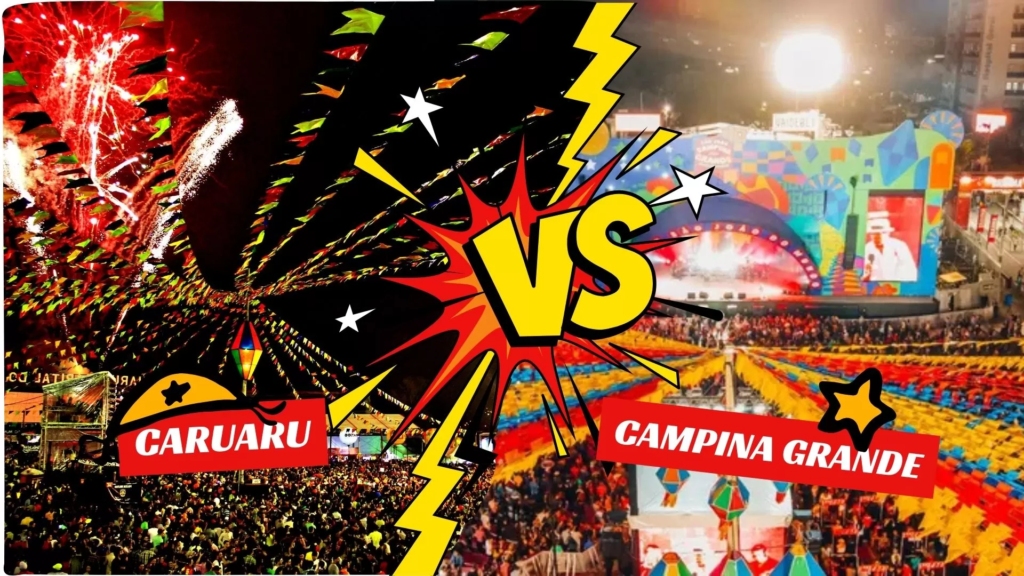
At the heart of Brazil’s June festival season lies one of the country’s most passionate cultural rivalries. The competition between Campina Grande and Caruaru for the title of “The Biggest Saint John’s Festival in the World” has evolved from friendly rivalry into a full-fledged cultural battle that drives innovation, attracts media attention, and ultimately benefits both cities and their celebrations.
Origins of the Dispute
The rivalry began to take shape in the 1980s and 1990s as both cities expanded their traditional community celebrations into major cultural events. Initially, the competition was relatively informal, with each city simply trying to outdo the other in terms of attractions and attendance.
However, as the economic and tourism potential of these festivals became increasingly apparent, the rivalry intensified. Municipal governments began investing more heavily in infrastructure, marketing, and programming. Both cities started actively promoting themselves as the definitive São João experience, each claiming to host the “authentic” and “largest” festival.
By the early 2000s, the competition had become institutionalized, with both cities using the disputed title “O Maior São João do Mundo” in their official marketing materials and making increasingly bold claims about attendance figures, duration, and cultural significance.
How the Rivalry Manifests
The competition between Campina Grande and Caruaru plays out in several dimensions:
Statistical One-upmanship: Both cities regularly publish statistics about their festivals, highlighting metrics that favor their claim to supremacy. Caruaru emphasizes its longer duration (72 days compared to Campina Grande’s 33) and claims larger overall attendance (4 million versus 2+ million). Campina Grande, meanwhile, highlights its concentrated intensity, larger daily attendance, and the purpose-built Parque do Povo venue.
Record-Breaking Attempts: The cities engage in a constant battle to set and break records related to June festivals. In 2024, Caruaru set the record for the largest quadrilha dance with 377 couples performing simultaneously. According to Harvard’s ReVista, Campina Grande “responded with a vengeance,” organizing its own record attempt the following year.
Celebrity Endorsements: Both festivals compete to secure appearances by Brazil’s biggest musical stars, with each trying to outdo the other with more impressive lineups. Artists often find themselves diplomatically navigating this rivalry, careful not to explicitly favor one festival over the other.
Media Coverage: The rivalry generates significant media attention, with Brazilian news outlets often framing their June festival coverage around the Campina Grande versus Caruaru competition. This narrative creates additional publicity that benefits both events.
Infrastructure Investments: The competition drives continuous improvements in festival infrastructure, with neither city wanting to be perceived as offering an inferior experience. This has led to better facilities, services, and programming for visitors to both festivals.
Local Perspectives on the Dispute
For residents of both cities, the rivalry has become an integral part of local identity and pride. Defending their city’s claim to have the superior festival is seen as a matter of civic duty.
In Campina Grande, locals emphasize the festival’s concentrated energy, the iconic Parque do Povo, and the city’s international recognition from UNESCO. As one resident put it: “Our São João is more authentic because it focuses on the traditional period. Caruaru starts in April – that’s not even June! They’re diluting the tradition just to claim they’re bigger.”
In Caruaru, residents point to the city’s deeper connection to Northeastern folk traditions, particularly through its famous handicraft tradition and the historic Caruaru Fair. “Our festival grows organically from our cultural identity,” explained a local artisan. “Campina Grande created an artificial venue for tourists. Our entire city becomes the festival.”
Festival organizers in both cities publicly maintain a respectful tone while subtly reinforcing their city’s claim to supremacy. As the director of Campina Grande’s festival stated diplomatically: “There’s room for everyone to celebrate our Northeastern traditions. We focus on quality and authenticity rather than just numbers.”
How the Rivalry Benefits Both Festivals
Despite the competitive rhetoric, the rivalry has ultimately proven beneficial for both cities and their festivals:
Continuous Innovation: The competition pushes both festivals to innovate and improve each year, preventing stagnation and ensuring fresh experiences for returning visitors.
Increased Visibility: The narrative of rivalry generates media coverage and public interest that might not exist if either festival stood alone.
Cultural Preservation: The competition incentivizes both cities to emphasize authentic cultural elements to bolster their claims of authenticity, helping preserve traditional aspects of the June festivals.
Economic Growth: The rivalry has driven increased investment in both festivals, expanding their economic impact and benefits for local communities.
Tourist Interest: Many visitors now make a point of attending both festivals to compare them firsthand, effectively doubling the tourism potential for the region.
As one tourism expert observed: “The ‘which is bigger’ debate is ultimately unanswerable – and that’s precisely why it’s so effective. It keeps people talking, comparing, and most importantly, visiting both festivals year after year.”
Who Really Has the Biggest São João?
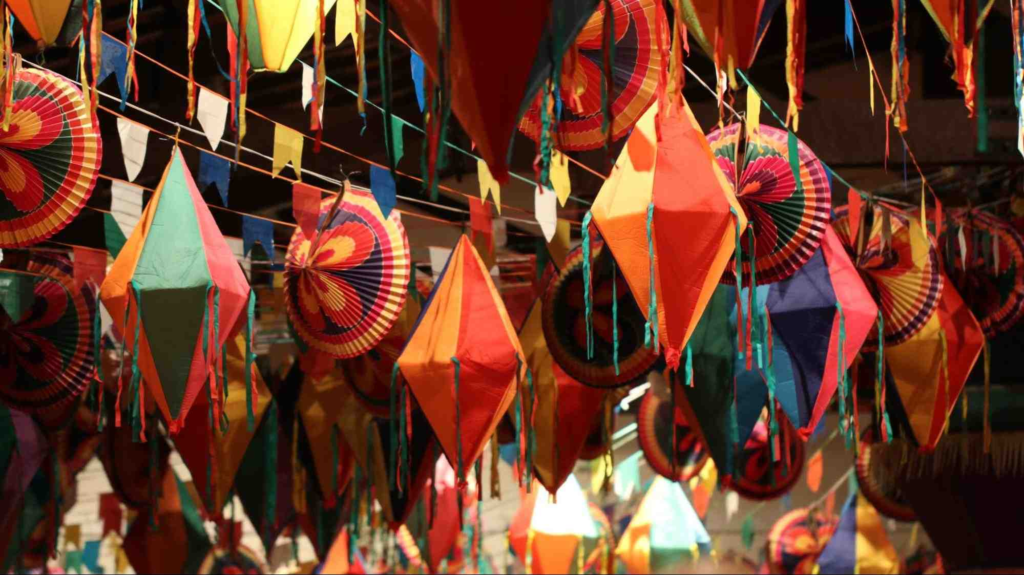
When comparing the São João festivals of Campina Grande and Caruaru, the question of which truly deserves the title of “biggest” becomes fascinatingly complex. Both festivals can legitimately claim superiority depending on which metrics are prioritized and how “biggest” is defined.
By the Numbers
Looking strictly at quantitative measures, both cities can make compelling cases:
Duration:
– Caruaru: 72 days (starting in April and running through June 2025)
– Campina Grande: 33 days (May 29 to June 30, 2025)
Caruaru clearly wins in terms of sheer duration, offering more than twice as many days of festivities. However, critics argue that by extending the celebration well beyond the traditional June period, Caruaru dilutes the authentic São João experience.
Attendance:
– Caruaru: Approximately 4 million visitors throughout the entire festival
– Campina Grande: More than 2 million visitors during its 33-day run
While Caruaru claims higher total attendance, Campina Grande often has larger daily crowds, with its Parque do Povo frequently hosting over 100,000 people on peak nights. The concentrated nature of Campina Grande’s festival creates a more intense atmosphere that many consider essential to the São João experience.
Programming:
– Caruaru: 1,200 attractions throughout the celebration
– Campina Grande: Over 700 hours of forró and more than 300 folkloric groups
Both festivals feature an impressive array of performances, with Caruaru offering more total attractions due to its longer duration, while Campina Grande provides a more concentrated cultural immersion.
Qualitative Comparisons
Beyond raw numbers, several qualitative factors distinguish the two festivals:
Venue and Infrastructure:
Campina Grande’s purpose-built Parque do Povo provides a centralized, cohesive festival experience with its Cidade Cenográfica (Scenographic City) creating an immersive environment. The infrastructure is specifically designed for large crowds and efficient movement between attractions.
Caruaru’s festival is more distributed throughout the city, with multiple venues including the Pátio de Eventos Luiz Lua Gonzaga and the Alto do Moura district. This creates a more integrated experience where the entire city participates, though it can make navigation more challenging for first-time visitors.
Cultural Authenticity:
Caruaru emphasizes its deep connection to Northeastern folk traditions, particularly through its famous handicraft tradition and the historic Caruaru Fair. The city’s year-round engagement with these cultural elements lends credibility to its claim of authenticity.
Campina Grande counters with its focused celebration of traditional June festival elements, particularly forró music and quadrilha dancing. Its recognition by UNESCO as part of the Creative Cities Network acknowledges its contribution to preserving and promoting traditional music and festivities.
Visitor Experience:
The experience of attending each festival differs significantly. Campina Grande offers a more concentrated, high-energy experience with its month-long celebration creating a sense of urgency and spectacle. The centralized venue makes it easier for visitors to navigate and experience multiple aspects of the festival in a single day.
Caruaru provides a more leisurely, immersive experience spread over more than two months. This allows visitors to explore different aspects of the celebration at a more relaxed pace and potentially return multiple times to experience different programming.
Tourist Perspectives
International tourists who have visited both festivals often report distinct impressions:
“Campina Grande feels more like a major event – it’s spectacular, energetic, and overwhelming in the best possible way,” said Maria, a tourist from Argentina. “The Parque do Povo creates this magical world that feels separate from everyday life.”
“In Caruaru, I felt like I was experiencing something more integrated with the city and its people,” commented Thomas from Germany. “It wasn’t just about attending a festival but about immersing myself in the culture of the Northeast. The artisans and their work were particularly impressive.”
Brazilian tourists often have strong opinions based on regional loyalties, but many acknowledge the unique strengths of each celebration. “They’re complementary experiences,” explained a visitor from São Paulo. “Ideally, you should experience both to understand the full spectrum of São João traditions.”
The Verdict: A Productive Tie
After examining all factors, the most honest conclusion might be that neither festival can definitively claim to be “bigger” in all respects. Each excels in different dimensions:
Caruaru offers the longer celebration, more total attractions, and deeper integration with the city’s year-round cultural identity, particularly its artisanal traditions.
Campina Grande provides the more concentrated, spectacular experience with its purpose-built venue, higher daily attendance, and international recognition.
As one Brazilian cultural commentator aptly put it: “The rivalry itself has become bigger than either individual festival. It’s a productive competition that has elevated both celebrations to international significance while preserving authentic Northeastern traditions. In that sense, the real winner is Brazilian culture.”
Perhaps the best approach for curious travelers is to follow the local advice: visit both festivals and decide for yourself which deserves the title of “O Maior São João do Mundo.”
Cultural and Economic Impact of the Festivals
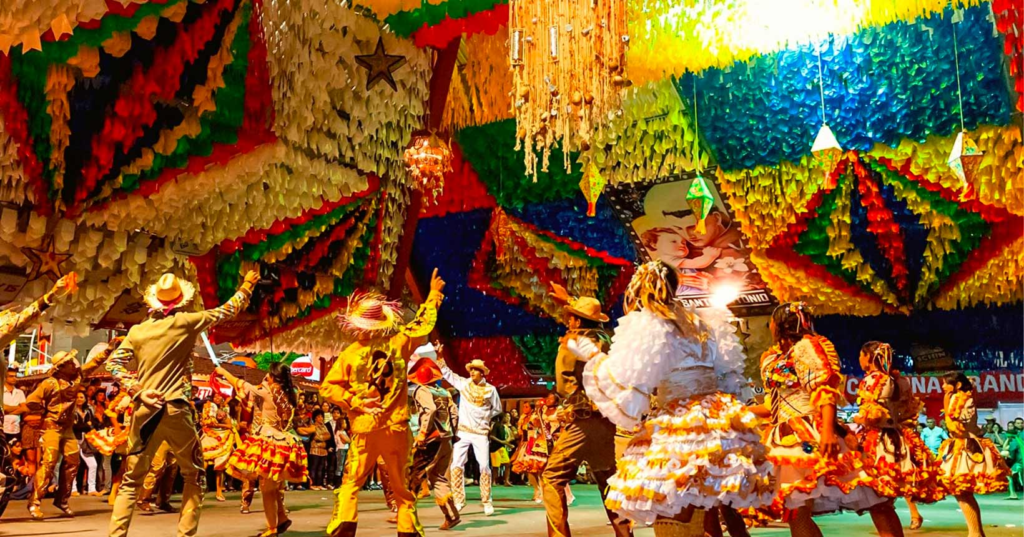
Beyond the friendly rivalry and tourist attractions, the São João festivals of Campina Grande and Caruaru represent powerful engines of cultural preservation and economic development for Brazil’s Northeast region. Their impact extends far beyond the festival periods themselves, influencing regional identity, economic opportunities, and Brazil’s cultural landscape.
Preserving and Reinventing Traditions
The festivals serve as crucial mechanisms for preserving Northeastern cultural traditions that might otherwise fade in an increasingly globalized world. By creating massive platforms for traditional music, dance, cuisine, and crafts, they ensure these cultural expressions remain vibrant and relevant.
Forró music, in particular, has benefited enormously from the visibility provided by these festivals. What began as regional folk music has gained national and even international recognition, with traditional artists finding new audiences and contemporary musicians incorporating forró elements into modern compositions.
The quadrilha dance competitions have evolved into elaborate artistic expressions, with choreographers and dancers developing increasingly sophisticated performances while maintaining connections to traditional forms. These competitions provide year-round activity for cultural groups, with rehearsals and preparations beginning months before the actual festivals.
Traditional crafts also flourish through the festivals’ marketplaces. In Caruaru especially, the celebration has helped preserve and promote the region’s distinctive clay figurine tradition, providing artisans with economic opportunities and recognition that sustain these practices across generations.
However, the festivals don’t merely preserve traditions in amber – they allow them to evolve and remain relevant. As one cultural anthropologist noted: “What makes these festivals so culturally significant is how they balance preservation with innovation, creating space for traditions to breathe and adapt to contemporary contexts.”
Economic Engine for the Northeast
The economic impact of these festivals is profound, particularly in a region that has historically been one of Brazil’s less economically developed areas. Some key economic effects include:
Tourism Revenue: The festivals generate millions of dollars in direct tourism spending. Hotels, restaurants, transportation services, and retail businesses see dramatic increases in revenue during the festival periods. In some cases, businesses earn 30-40% of their annual income during these few weeks.
Job Creation: Thousands of temporary jobs are created each year, from construction workers building festival infrastructure to service staff, security personnel, and performers. These opportunities provide crucial income for many families.
Year-Round Tourism Development: The international recognition gained through the festivals has helped both cities develop more sustainable year-round tourism. Many first-time visitors during São João return at other times of year to explore the region further.
Creative Economy Growth: The festivals have stimulated growth in the creative and cultural sectors, with increased demand for musicians, dancers, choreographers, costume designers, set builders, and other creative professionals.
Small Business Opportunities: Local entrepreneurs find numerous opportunities during the festivals, from food vendors to souvenir sellers to transportation providers. Many small businesses that start during the festival season eventually grow into year-round operations.
Infrastructure Improvements: To accommodate the massive influx of visitors, both cities have invested in infrastructure improvements that benefit residents year-round, including better roads, public transportation, and public spaces.
According to economic impact studies, events similar to these festivals can inject approximately US$30 million into local economies. The multiplier effect of this spending ripples throughout the regional economy, supporting businesses and families far beyond those directly involved in the celebrations.
International Cultural Diplomacy
The São João festivals have increasingly become tools of cultural diplomacy, showcasing Brazilian culture to international visitors and media. As Brazil seeks to diversify its international image beyond the beaches of Rio and the Amazon rainforest, these authentic cultural celebrations offer a window into the country’s rich regional diversity.
Campina Grande’s recognition by UNESCO as part of the Creative Cities Network has further elevated the international profile of these celebrations. This designation acknowledges the festival’s role not just as a tourist attraction but as a significant contribution to global cultural heritage.
Foreign visitors often describe their experience at these festivals as transformative, offering insights into Brazilian culture that go far beyond typical tourist experiences. “I’ve been to Carnival in Rio, but São João in the Northeast showed me a completely different side of Brazil,” commented one American visitor. “It felt more authentic, more connected to the people and their everyday lives.”
Social Cohesion and Regional Identity
Perhaps the most profound impact of these festivals is how they strengthen social bonds and regional identity. In a country as vast and diverse as Brazil, these celebrations help define and reinforce Northeastern cultural identity, creating pride in regional traditions and heritage.
The festivals provide rare opportunities for intergenerational cultural transmission, with grandparents, parents, and children participating together in traditions that span centuries. They also create spaces where social hierarchies temporarily dissolve, with people from all walks of life dancing, eating, and celebrating together.
For Northeasterners who have migrated to other parts of Brazil for economic opportunities, the festivals represent important occasions to reconnect with their cultural roots. Many make annual pilgrimages back to the region specifically to participate in these celebrations, maintaining ties to their communities of origin.
As one sociologist studying the festivals observed: “These aren’t just entertainment events – they’re complex social institutions that build community resilience, preserve cultural knowledge, and create shared experiences that bind people together across differences of class, age, and background.”
Practical Guide for Visitors: How to Enjoy the Festivals

If you’re planning to experience the legendary São João festivals of Campina Grande and Caruaru, this practical guide will help you make the most of your visit. From transportation and accommodation to cultural tips and itinerary suggestions, here’s everything you need to know to navigate these spectacular celebrations.
When to Visit
Campina Grande: In 2025, the festival runs from May 29 to June 30. The most intense period is around June 24 (Saint John’s Day), when the largest crowds and most spectacular events occur. Weekends generally feature the biggest musical attractions.
Caruaru: The 2025 celebration begins in April and continues through June 28, with a remarkable 72-day duration. The core festivities intensify in June, particularly around June 24. If you want to experience the festival at its peak, mid-to-late June is ideal.
For those who want to compare both festivals, plan your trip for mid-June when both celebrations are in full swing. With the cities located approximately 200 kilometers (124 miles) apart, it’s feasible to experience both in a single trip.
How to Get There
Getting to Campina Grande:
– By Air: The nearest airport is João Suassuna Airport (CPV) in Campina Grande, which receives domestic flights from major Brazilian cities. Alternatively, you can fly into João Pessoa International Airport (JPA), about 120 kilometers (75 miles) away, which offers more flight options.
– By Bus: Intercity buses connect Campina Grande to major Northeastern cities. During the festival, special services often increase in frequency.
– By Car: If you’re comfortable driving in Brazil, renting a car gives you flexibility to explore the region. The BR-230 highway connects João Pessoa to Campina Grande.
Getting to Caruaru:
– By Air: The closest major airport is Recife/Guararapes International Airport (REC), approximately 130 kilometers (80 miles) away. From there, you can take a bus or rent a car to reach Caruaru.
– By Bus: Regular bus services connect Caruaru to Recife and other major cities in the Northeast.
– By Car: The BR-232 highway connects Recife to Caruaru, with a driving time of about 2 hours.
Traveling Between the Festivals:
– By Bus: Intercity buses connect Campina Grande and Caruaru, with a journey time of approximately 3 hours.
– By Car: The drive between the two cities takes about 2.5-3 hours, primarily via the BR-104 highway.
– Organized Tours: During the festival season, some tour operators offer packages that include visits to both cities.
Accommodation Options
In Campina Grande:
– Hotels: The city has a range of hotels from budget to upscale. Recommended options include Hotel Village Premium, Hotel Slaviero Essential, and Nord Luxxor Campina Grande.
– Guesthouses (Pousadas): For a more personal experience, consider smaller guesthouses like Pousada do Conde or Pousada Tropicana.
– Apartment Rentals: Platforms like Airbnb offer numerous options, from single rooms to entire apartments.
In Caruaru:
– Hotels: Options include Hotel Lider, Hotel Portal de Caruaru, and Hotel Village.
– Guesthouses: Smaller establishments like Pousada São Francisco offer more intimate accommodations.
– Apartment Rentals: Short-term rentals are increasingly available through online platforms.
Important Accommodation Tips:
– Book well in advance – at least 3-6 months before the festivals, as accommodations fill up quickly.
– Expect higher prices during the festival period, often 30-50% above normal rates.
– Consider staying slightly outside the city centers for better rates and availability.
– Confirm whether your accommodation offers transportation to festival venues.
Essential Experiences
In Campina Grande:
– Spend at least one full evening at Parque do Povo, experiencing the main stages and Cidade Cenográfica.
– Take a ride on the Trem do Forró for a unique musical journey through the countryside.
– Watch the quadrilha competitions, which showcase elaborate choreography and costumes.
– Visit the Ilha do Maior São João do Mundo cultural center to learn about the festival’s history.
– Experience the spectacular fireworks displays that light up the night sky.
In Caruaru:
– Explore the famous Caruaru Fair (Feira de Caruaru) to see traditional handicrafts and sample regional foods.
– Visit the Alto do Moura district to watch master clay artisans at work and purchase unique souvenirs.
– Attend performances at the Pátio de Eventos Luiz Lua Gonzaga, the main venue for large concerts.
– Sample traditional June festival foods from the numerous food stalls throughout the city.
– If possible, take a day trip to the nearby Museum of the Man of the Northeast in Recife.
Cultural Tips and Etiquette
- Dress Code: Casual and comfortable clothing is appropriate. Many visitors embrace the festival spirit by wearing traditional “caipira” outfits – checkered shirts, straw hats, and denim for men; colorful dresses with patches and braided hair for women.
- Dancing: Don’t be shy about joining in the forró dancing! Locals are usually happy to teach beginners the basic steps. The dance involves close contact, which is normal and expected.
- Language: While Portuguese is the primary language, festival staff at major venues often speak some English. Learning a few basic Portuguese phrases will enhance your experience.
- Safety: The festivals are generally safe, but standard precautions apply – keep valuables secure, stay aware of your surroundings, and avoid isolated areas late at night.
- Weather: June in Northeast Brazil is typically mild, with temperatures ranging from 18-28°C (64-82°F). Evenings can be cooler, so bring a light jacket.
Suggested Itineraries
For a 5-Day Visit to Both Festivals:
– Day 1: Arrive in Recife, travel to Caruaru, and spend the evening exploring the Caruaru Fair.
– Day 2: Full day in Caruaru, visiting Alto do Moura in the morning and attending festival events in the evening.
– Day 3: Travel to Campina Grande in the morning, explore the city, and visit Parque do Povo in the evening.
– Day 4: Take the Trem do Forró excursion during the day, then return to Parque do Povo for the evening celebrations.
– Day 5: Final morning in Campina Grande before departing.
For a Dedicated Campina Grande Experience (3 Days):
– Day 1: Arrive and attend evening events at Parque do Povo.
– Day 2: Visit the Ilha do Maior São João do Mundo in the morning, take the Trem do Forró in the afternoon, and return to Parque do Povo at night.
– Day 3: Explore the city center in the morning, watch quadrilha competitions in the afternoon, and enjoy final evening celebrations.
For a Dedicated Caruaru Experience (3 Days):
– Day 1: Arrive and visit the Caruaru Fair, followed by evening festivities.
– Day 2: Spend the morning in Alto do Moura, then attend performances at the Pátio de Eventos in the evening.
– Day 3: Explore more of the city’s cultural attractions before final evening celebrations.
Practical Tips
- Money: While credit cards are widely accepted at larger establishments, carry some cash for smaller vendors, especially at the fairs and markets.
- Transportation: During the festivals, cities become congested. Consider using official festival shuttle services where available.
- Food and Drink: Stay hydrated, especially if you’re dancing. Try traditional foods like pamonha (corn paste), canjica (sweet corn pudding), and pé de moleque (peanut candy).
- Tickets: While many festival areas are free to enter, special concerts may require tickets. Check official festival websites for information.
- Technology: Download offline maps and translation apps before your trip. Consider purchasing a local SIM card for data access.
- Health: Bring basic medications, sunscreen, and insect repellent. Medical posts are available at major festival venues.
By planning ahead and embracing the festive spirit, you’ll be well-prepared to experience the magic of Brazil’s greatest June festivals. Whether you choose Campina Grande, Caruaru, or both, you’re in for an unforgettable cultural immersion that showcases the heart and soul of Brazil’s Northeast.
Conclusion: Two Giants of Brazilian Culture
As we’ve explored the spectacular São João festivals of Campina Grande and Caruaru, one thing becomes abundantly clear: the question of which city hosts “The Biggest Saint John’s Festival in the World” may be ultimately unanswerable – and perhaps that’s for the best.
These two remarkable celebrations, each with its own distinctive character and approach, represent different but equally valid expressions of Brazil’s rich Northeastern cultural heritage. Rather than viewing them as competitors in a zero-sum contest, we might better appreciate them as complementary showcases of a tradition that deserves wider international recognition.
Campina Grande offers a concentrated, spectacular experience centered around its purpose-built Parque do Povo. Its 33-day celebration creates an intense, immersive environment where visitors can experience the full spectrum of São João traditions in a cohesive, carefully designed setting. The city’s recognition by UNESCO acknowledges its significant contribution to preserving and promoting these cultural expressions.
Caruaru, meanwhile, presents a more extended, distributed celebration that integrates deeply with the city’s year-round cultural identity. Its remarkable 72-day festival allows for a more leisurely exploration of June traditions, while its connection to the famous Caruaru Fair and Alto do Moura artisanal district provides additional dimensions to the cultural experience.
The rivalry between these cities, while sometimes appearing contentious, has ultimately benefited both festivals and the broader cultural landscape. It has driven innovation, increased visibility, attracted investment, and ensured that these traditions remain vibrant and evolving rather than becoming static museum pieces.
For international visitors seeking authentic cultural experiences beyond Brazil’s more familiar attractions, these festivals offer unparalleled opportunities to engage with the country’s regional diversity. The music, dance, food, crafts, and communal spirit of São João provide insights into Brazilian identity that can’t be found on the beaches of Rio or in the business districts of São Paulo.
As Brazil continues to develop its cultural tourism offerings, the São João festivals of the Northeast deserve to take their place alongside Carnival and the Amazon as essential experiences for understanding this complex, fascinating country. Whether you choose Campina Grande, Caruaru, or ideally both, you’ll discover a celebration that embodies the warmth, creativity, and joyful spirit of the Brazilian people.
The debate over which festival is truly “bigger” will undoubtedly continue for years to come, with each city finding new ways to assert its claim to the title. But perhaps the most honest conclusion is that both have achieved something remarkable: transforming local traditions into world-class cultural events while maintaining their authentic connection to the communities that created them.
In the words of one Brazilian cultural commentator: “The real winner in this friendly rivalry is Brazilian culture itself – and anyone fortunate enough to experience these magnificent celebrations.”
